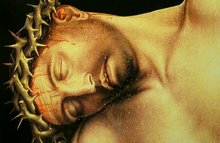Bach's Breakthrough Chorales
Bach was never more brilliant than in the originality of his chorale harmonizations. The "science" of musical harmony was formed by Jean-Philippe Rameau in 1726, the year before St. Matthew Passion was composed. Since Bach didn't know the "rules" he was free to explore theretofore unknown harmonies. Almost every composition student uses the corpus of Bach's chorale settings as a textbook. One has to wonder why, in college harmony classes, the ideal is to keep the alto and tenor lines as close to a monotone as possible. Bach goes wild -- cross voices, false relations, savage chromaticism -- whatever is necessary to create a melody of interest in all the parts, not just the soprano. My prof told us, in analysis class, that the chord progression which opened the door to modern music was the first phrase of the "Love Death" (Liebestodt). But he surely must have heard Bach's chorale setting of "Es ist genug." Rameau could have analyzed the Wagner but he would have been hard pressed to figure the Bach. Alban Berg understood. He based his violin concerto on the Bach.




